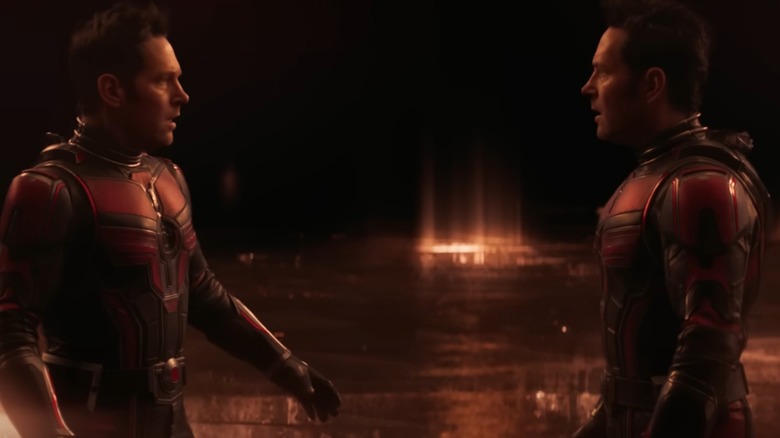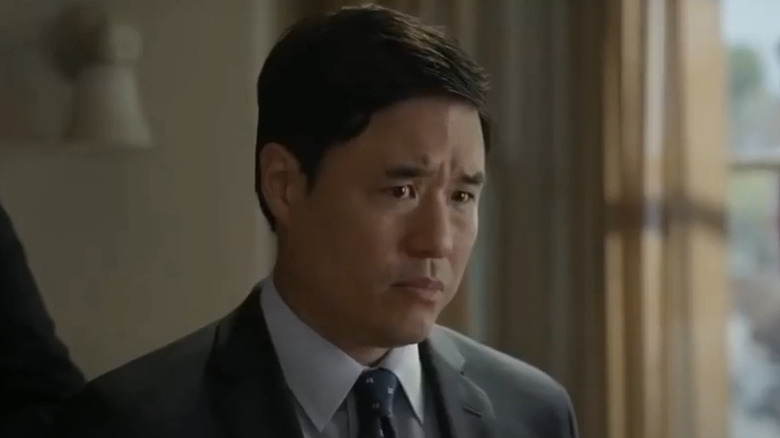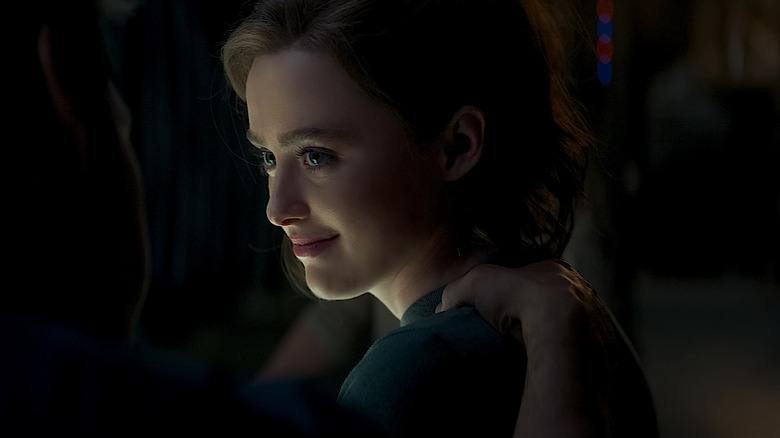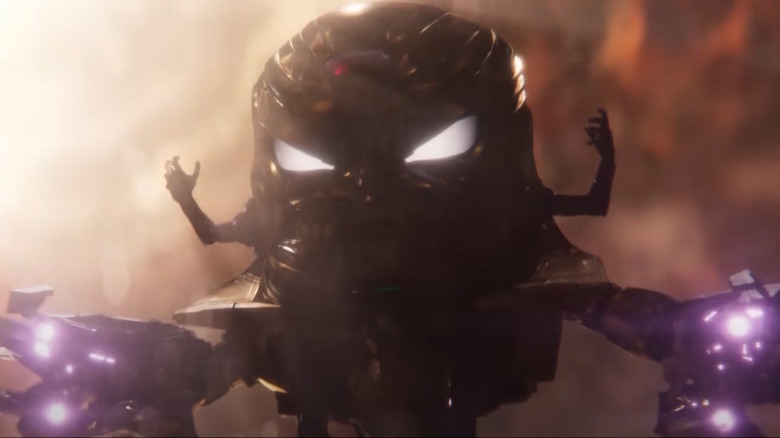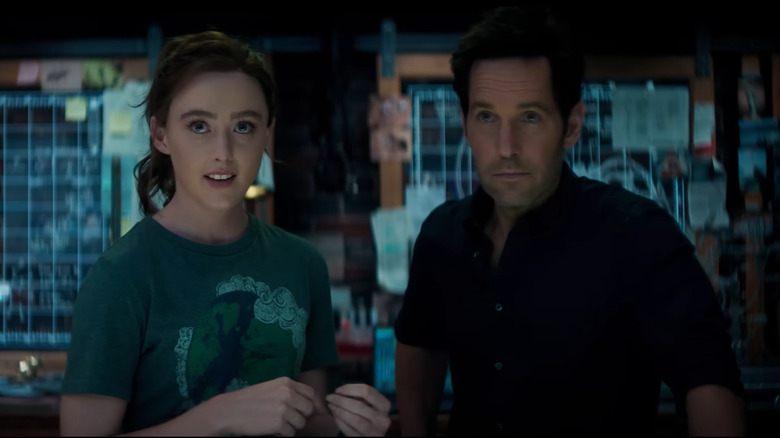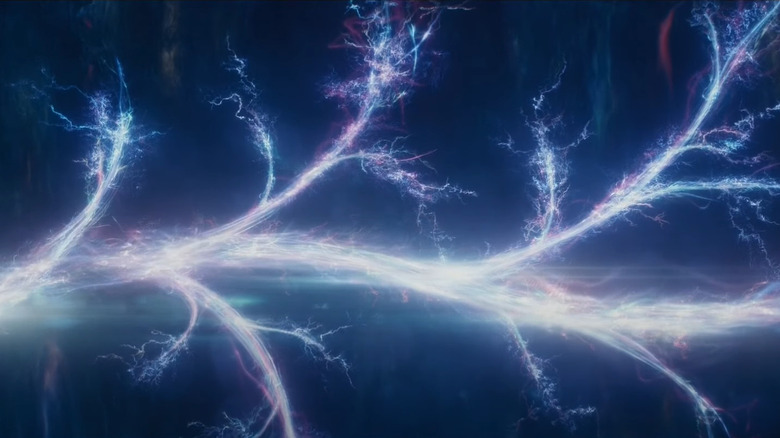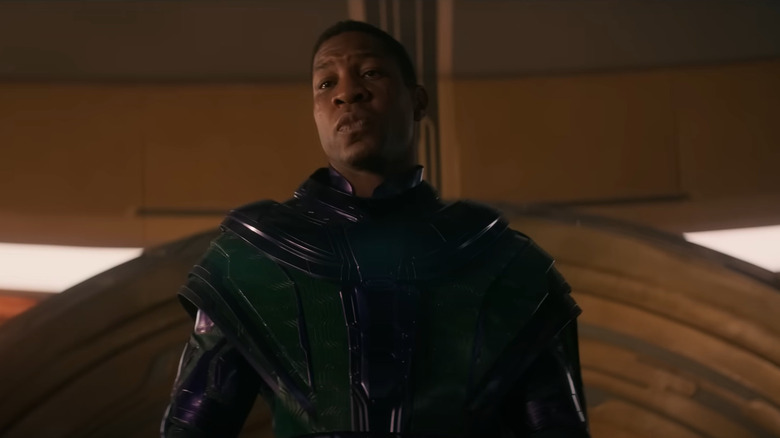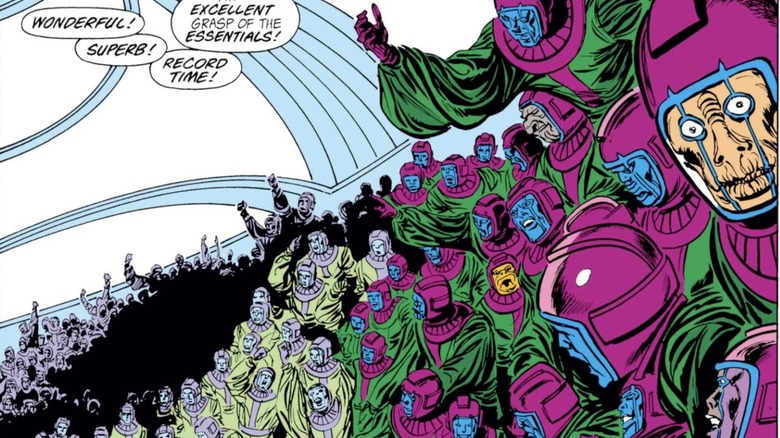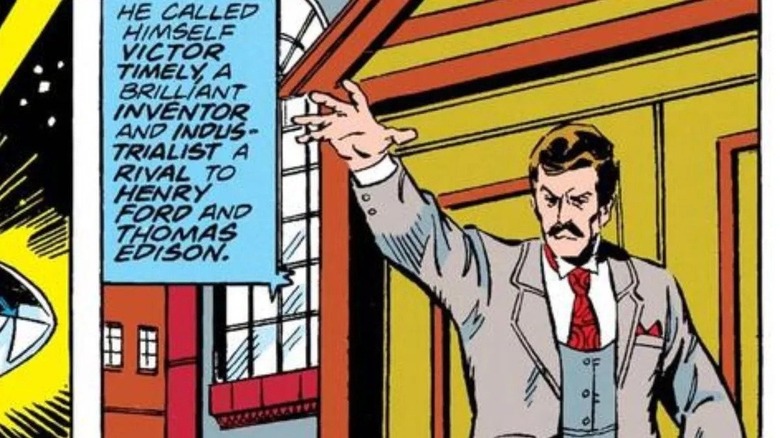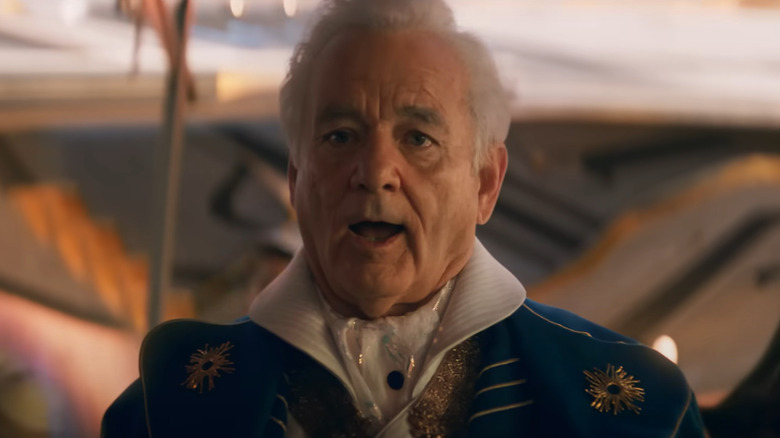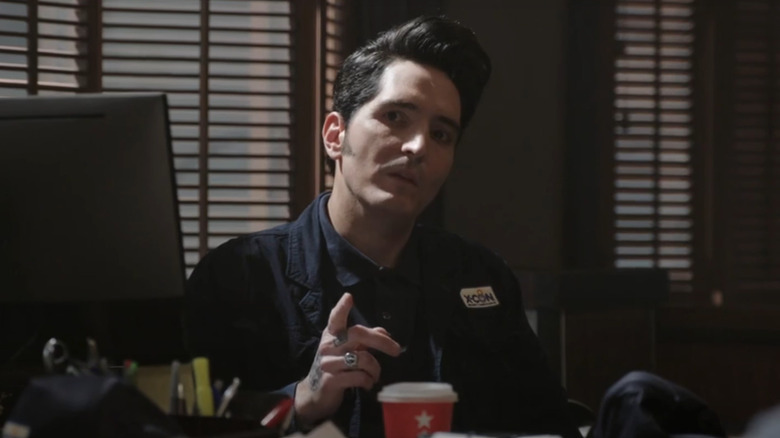The Coolest Easter Eggs We Found In Ant-Man And The Wasp: Quantumania
The hotly anticipated "Ant-Man and the Wasp: Quantumania" has finally been released, and boy, is it a doozy! Scott Lang (Paul Rudd), Hope van Dyne (Evangeline Lilly), and the others embark on their trippiest adventure yet. Scott's daughter, Cassie (Kathryn Newton), has been researching the Quantum Realm, creating a device that sends a signal into the mysterious microscopic universe. However, her experiment results in Cassie, Scott, Hope, Hank Pym, and Janet Van Dyne (Michelle Pfeiffer) getting stuck in the Quantum Realm, and they must find a way back home. But before they can do that, they have to contend with the incredibly powerful figure, Kang the Conqueror (Jonathan Majors), who has been exiled there and has a connection to Janet from when she spent all of those decades in the Quantum Realm. Can our minuscule heroes return to where they came from without letting Kang out of his prison?
As with most films in the sprawling franchise, "Ant-Man and the Wasp: Quantumania" establishes massive ramifications for the future of the Marvel Cinematic Universe. Of course, there are also plenty of fun little references to events of previous installments, giving eagle-eyed viewers and longtime fans an extra treat. Below are the coolest Easter eggs we found in the latest MCU film.
Is that you, Jimmy Woo?
Jimmy Woo (played by Randall Park) first appeared in "Ant-Man and the Wasp" as an FBI Agent assigned to surveil Scott Lang during house arrest following the events of "Captain America: Civil War." While Woo was pretty frustrated with Lang's antics, he nevertheless had some respect for the ex-convict turned Avenger. Woo showed up again in the Disney+ series, "WandaVision," this time as an agent of SWORD (Sentient Weapon Observation and Response Division) investigating what Wanda Maximoff is doing in Westview.
Park reprises the role, albeit briefly, having lunch with Lang. They seem pretty chummy these days, as Woo has probably come to the conclusion that Ant-Man has done more good than harm. We're not given any hints as to what part Woo has to play in the wider MCU, but it's nice to know that Marvel Studios has kept him around. SWORD has a pretty big presence in the comics, so hopefully, we'll see more of the agent in the future.
Cassie Lang's introduction is more important than you think
Despite his many flaws, Scott Lang genuinely loves his daughter, Cassie, who was first introduced in "Ant-Man" and was later seen in "Ant-Man and the Wasp" and "Avengers: Endgame." In "Ant-Man and the Wasp: Quantumania," little Cassie is all grown up. Now that Lang is on a break from his superhero life, he's doing everything he can to be a good father. However, that's still not enough, as she's been getting into trouble with the law lately. At the beginning of the movie, Scott gets a call from the police to pick her up from jail, as she was arrested for protesting the removal of a homeless encampment.
On its surface, this is to show that she takes after her dad's kind-hearted yet felonious ways. However, true MCU fans will note that this is a more direct reference to our introduction to Scott in the first "Ant-Man" film and his last day in prison, where he's picked up by his buddy Luis (Michael Peña). It's a great little callback to a previous film and further establishes the unique relationship between the two characters.
MODOK heads into the MCU
The last time we saw Corey Stoll's Darren Cross was in the first "Ant-Man," in which he was Hank Pym's former colleague who grew resentful of him and made his own version of the Pym particle. Of course, possessing such a powerful resource got to his head, so he designed an incredibly dangerous suit and became the Yellowjacket. During their fight in Cassie's bedroom, Ant-Man went subatomic, sabotaged Darren's suit, and seemingly killed him.
However, "Ant-Man and the Wasp: Quantumania" reveals that Darren didn't die but was actually sent to the Quantum Realm. His body was warped, giving him a disproportionately massive head and small arms and legs. Kang the Conqueror found him and gave him a new robotic body. This new form is known as Mechanized Organism Designed Only for Killing or MODOK. It's an over-the-top look, but it comes straight out of the comics, so points go to the film's creators for staying true to the source material.
Cassie Lang attains... stature
Cassie takes after her father. She's been to jail, she has a knack for engineering, and she can change size. It's not only revealed that Cassie has a size-changing suit, but in one standout moment, Cassie becomes massive — just like her old man. Of course, this isn't just a cute way to show how much Scott inspired her. This is straight out of the source material. In the comics, Cassie becomes a superhero known as Stature, who can alter her size at will. We've heard rumblings of Marvel Studios developing a "Young Avengers" movie. Is Cassie's "growth" a sign of things to come?
On a side note, there's another fun little callback to a previous Marvel movie during Cassie's enlargement. When she shrinks down to her normal size after helping her giant father, she says she's craving limes. Scott is delighted by this, noting that the process of growing always leads to an appetite for citrus, as evidenced by his desire for orange slices after his fight in "Captain America: Civil War."
That multiversal map looks familiar...
When Kang first arrives in the Quantum Realm and meets the similarly trapped Janet Van Dyne, he comes off as a sympathetic character searching for a way back to his home. However, it's soon revealed that he was on a mission to conquer every timeline, but because of his warring ways, he was exiled to the microscopic dimension. Later, as he explains his plan to Janet, he pulls up a digital map of the multiverse and its countless timelines. This may simply seem like a way to depict how the different realities interact with and branch off from one another in the MCU, but there's a little more significance behind that multiversal map. It's nearly identical to the one displayed numerous times in the Disney+ series "Loki," which deals heavily with the multiverse.
What the heck are incursions?
Near the big climax of the film, Kang mentions "incursions." However, this isn't just a piece of science fiction. We first heard this term in the post-credits scene of "Doctor Strange in the Multiverse of Madness," when Clea (Charlize Theron) appears and tells the good doctor that he caused an incursion, and she needs his help to fix it before ripping a hole in reality.
However, that still doesn't explain what an "incursion" is. To fully answer that, we need to turn to the comics. During Jonathan Hickman's run on "Avengers" and "New Avengers," and leading up to the crossover, "Secret Wars," incursions are instances in which the multiverse shrinks, leading to universes colliding with each other and getting destroyed in the process. Considering that Marvel Studios is releasing "Avengers: Secret Wars" in 2026 and has been using the multiversal elements from the comics throughout its recent phases, it's pretty safe to assume that we're going to hear more about incursions in future films and series.
The Council of Kangs
"Ant-Man and the Wasp: Quantumania" gave us a real doozy of a mid-credits scene. While Kang the Conqueror (seemingly) died during his final fight with Ant-Man and the Wasp, the mid-credits scene gave us a whole population of Kang variants. Three versions of Kang are worth pointing out: Immortus, Rama-Tut, and another who bears some resemblance to the Scarlet Centurion. These Kang variants have deep histories in Marvel Comics, so their appearances foreshadow some exciting things from Marvel Studios.
But there's more. As the camera pans away from Immortus, Rama-Tut, and the maybe-Scarlet Centurion, we see a stadium filled to the brim with variants of Kang the Conqueror. This not only gives us a hint of how prevalent the threat of Kang will be in the Marvel Cinematic Universe but is also an almost exact recreation of the above panel from 1988's "Avengers #292." Boy, those people at Marvel Studios sure do their homework.
Time for Victor Timely
The end credits scene of "Ant-Man and the Wasp: Quantumania" is set in what appears to be the early 1900s, with yet another Kang variant. This one, known as Victor Timely, demonstrates a strange device to a gathering of people while talking about the malleability of time. As if that wasn't intriguing enough, Loki and Mobius M. Mobius are seen in the crowd, possibly there as part of some trip to clean up the timeline after the events of "Loki." The God of Mischief tells Mobius that Victor is the one. Mobius expresses his surprise at the seeming huckster being much of a danger. Loki, however, confirms that Victor Timely is a genuine threat.
What's the deal with Krylar?
When Bill Murray was first announced to join the cast of "Ant-Man and the Wasp: Quantumania," fan speculation ran wild as to who he would play. Would he play an existing character from the comics or a new character created just for the movie? Well, now we know that he was cast to play Krylar. Krylar is a deep cut from Marvel Comics lore. He is an inhabitant of K'ai, a planet in the Microverse (the comic book version of the Quantum Realm). Krylar only appeared in a single issue, "Incredible Hulk" #156, which may explain why his presence in the film is so small.
Did you catch David Dastmalchian's return?
Anyone who's seen the previous "Ant-Man" films remembers David Dastmalchian's character, Kurt, a member of Scott Lang's group of thieves. While those guys didn't appear in "Ant-Man and the Wasp: Quantumania," Dastmalchian does appear in the film, or rather, his voice is heard. The actor voices Veb, a pink, slime-based creature that inhabits the Quantum Realm and has a fascination with other characters', um, holes. That will make slightly more sense when you see the film.
